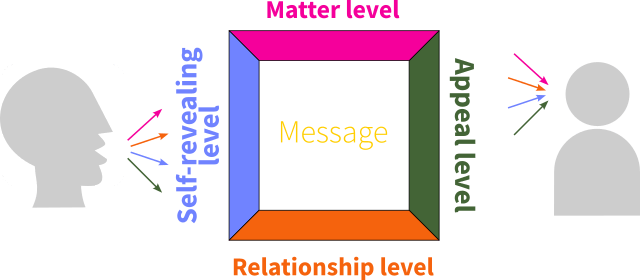Four-Sides Model
People usually have a simplistic view of how communication between persons takes place: one person is the “transmitter” of a message or information, and the second person is the “recipient” of that message or information. The many misunderstandings and conflicts between people prove that in practice things tend to be more complicated. Based on the ideas of Paul Watzlawick and others, the German psychologist Friedemann Schulz von Thun developed the “Four-sides model”, which divides the communication process into four levels:

The matter level is the factual content of the message.
The relationship level includes information about what the speaker thinks about the other person and how the speaker sees their relationship.
The appeal level relates to what the speaker expects the other person to do after receiving the message.
The self-revealing level discloses information about the transmitter’s motivation, feelings, etc.
Example
Several participants have arrived late to the start of the class. Before the break the teacher tells the participants that class will resume after the break at 19:00 sharp.
What this message could present on Schultz von Thun’s four levels:
- Matter level: Factual information about when the class will resume.
- Appeal level: The teacher wants the participants to be back in time; or he/she wants to make the late-comers feel bad about being late in the morning.
- Self-revealing level: Discloses that the teacher is still annoyed by participants being late; or that he is concerned about not getting through the whole programme in time.
- Relationship level: Demonstrates that “I am the teacher and you are the participants”, showing anger, dissatisfaction, or anxiousness towards the participants.
The communication process becomes even more complex when taking into consideration that, depending on what level the recipient draws attention to, the meaning of the message can be understood in different ways. In accordance with the four levels of a message, the recipient listens with four different ears. Schulz von Thun offers this example:
A car stands in front of a traffic light. A woman is at the wheel. Next to her sits a man and says: “It’s green”.
The woman’s reaction will depend on the ear with which she perceives this message. For example:
- Matter level: She replies: “Are you talking about the traffic light or the trees by the side of the road?”
- Appeal level: She starts driving.
- Self-revealing level: She replies: “Don’t worry, we’ll make it in time for the start of the football match”.
- Relationship level: She replies: “I’m not blind”.
Try it yourself
I, You, We – Messages
The sender also always includes information about how he/she perceives:
- Oneself – “I-message”.
- The other – “You-message”.
- Their relationship – “We-message”.
Example
The teacher says: “Last week I attended a conference In Dublin, where my friend professor Huth expressed this interesting idea…”
- „I-message”: “I am an expert who attends conferences abroad and I have important people as friends”.
- „You-message”: “You are just participants, who know much less about this topic than I do”.
- „We-message”: “I am superior, but I don’t mind enlightening you”.
The receiver has four possibilities for how to react to this view:
- Agree: “I agree with how you see yourself, myself, and our relationship.”
- Accept: “Well, I have a different perspective on this but I don’t mind how you see things.”
- Deny: “Wait a moment, this is not how I perceive you.”
- Ignore: “You are nothing to me”.
The receiver’s reaction is usually not expressed explicitly. Instead, it is expressed through intonation, mimic, or gestures at the relationship level of communication.


